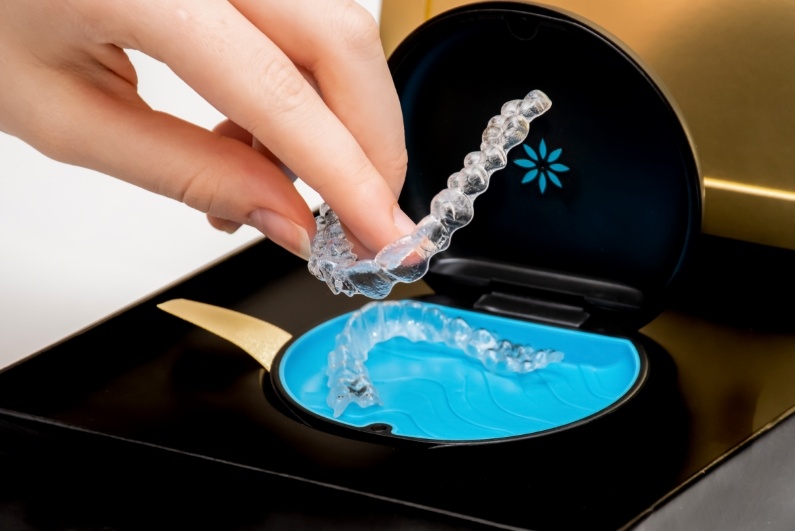How Does Invisalign Work?
-
Series of Clear Aligners
-
Must Be Worn 22 Hours Per Day
-
Takes About 12 Months on Average
-
No Metal Brackets & Wires!
Learn More
Who Can Invisalign Help?
-
Crowded Teeth
-
Gaps Between Teeth
-
Bite Alignment
Learn More
Benefits of Invisalign
-
Nearly Invisible
-
Removable for Brushing & Flossing
-
No Dietary Restrictions
-
Shorter Treatment Time
-
Comfortable, Secure Fit
-
Less Time in the Treatment Chair
Learn More
Living with Invisalign Aligners
-
Wearing Your Trays
-
Cleaning Your Aligners
-
Eating & Drinking
-
Losing or Damaging a Tray
-
Routine Check-Ins
Learn More
Understanding the Cost of Invisalign
-
Every Treatment Plan is Unique
-
Invest in Quality & Peace of Mind
-
Dental Insurance May Help Offset Cost
-
Low-Interest Financing is Available
Learn More
Invisalign FAQs
What Does Invisalign Look Like?
If you’ve never seen Invisalign before, they are quite distinct. They are comprised of durable, clear plastic and are shaped to snugly fit against your teeth. Sometimes, additional appliances are required, like buttons or elastics, which can change their appearance a bit. It’s important to note that the aligners can discolor over time, taking on a yellow or dull appearance. That’s why it’s of the utmost importance that you care for them properly, cleaning them daily and taking them out when you eat or drink (water is the only exception).
Does Invisalign Hurt?
Since your teeth are being moved into an entirely new position, orthodontic treatment of any kind comes with some discomfort. The good news is that Invisalign is much more comfortable than traditional braces – there are no metal brackets and wires, after all! Plus, the smooth aligners are custom-made just for you, minimizing irritation to your lips, cheeks, and gums. Any soreness that you do experience can be mitigated with a cold compress or an OTC pain reliever.
What Happens After Invisalign?
Invisalign can effectively straighten your teeth, correcting everything from minor spacing issues to more moderate crowding. Maintaining your new and improved smile throughout the years, however, is on you. To prevent orthodontic relapse, our cosmetic dentist in Ormond Beach will provide you with a retainer. This oral appliance should be worn for 22 hours a day for at least the first six months after completing your series of aligners. From there, you will be able to slowly transition to wearing them solely at night. This is one of the best ways to ensure you don’t experience any unwanted movement in your teeth.
What if My Invisalign Aligner Broke?
Did your aligners crack or break into multiple pieces? If so, do your best not to panic and do NOT use a household item, like superglue, to piece it back together. Instead, get in touch with your dentist. Since they are familiar with where you are in your treatment timeline, they’ll be able to determine the next best steps. For example, if you’re only a day away from transitioning to your next set of trays, they may advise you to begin early. If you’re right in the middle of that set of trays, then they may recommend having a replacement one made and wearing your previous aligners in the meantime.
Is Invisalign Cheaper than Braces?
In most cases, Invisalign in Ormond Beach costs about the same as traditional braces, though exact pricing depends on the complexity of your case and treatment duration.
Generally, mild alignment issues are less expensive, while more involved cases cost more. While braces can sometimes be slightly cheaper upfront, Invisalign offers unique advantages that many patients find are well worth the investment. For example, the aligners are clear, disappearing into your smile while worn. You’ll also enjoy fewer office visits and no diet restrictions.
Our team will always give you an estimate of your costs before treatment begins, so there are no surprises. We believe our pricing policy should be as clear as our aligners.
What Are Invisalign Attachments?
Attachments, also called “buttons,” are small, tooth-colored bumps made of dental resin that are temporarily bonded to strategic teeth during your treatment. These buttons are like tiny handles that help the aligners apply more precise pressure in specific directions. This allows them to move more efficiently and in more complicated directions.
Not every Invisalign patient needs them, but when they’re used, attachments make it possible to correct more complex alignment issues without resorting to brackets and wires.
The attachments also blend in with your natural enamel and are virtually invisible when your aligners are in place. So, there’s no need to worry about them sticking out during your treatment.
Who Invented Invisalign?
Invisalign was invented in the late 1990s, not by a dentist, but by Zia Chishti, a Stanford University Computer Science and Economics graduate.
During his time at Stanford, he underwent orthodontic treatment with traditional braces and became frustrated with their limitations. He envisioned an invisible alternative that could be removed. He worked with the concept in his dorm room and eventually enlisted the aid of Kelsey Wirth, a business and public policy student who could help him shape his ideas.
In 1997, they founded Align Technology and launched Invisalign shortly after in 1998. Since then, Invisalign has revolutionized orthodontics and cosmetic dentistry, offering options where none existed before.






